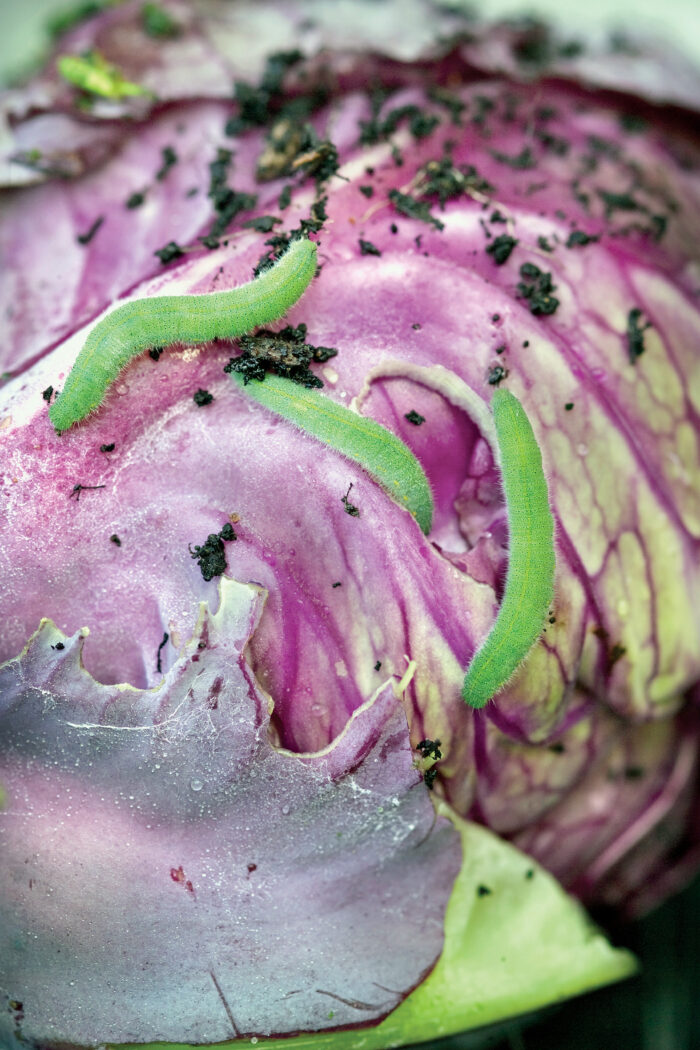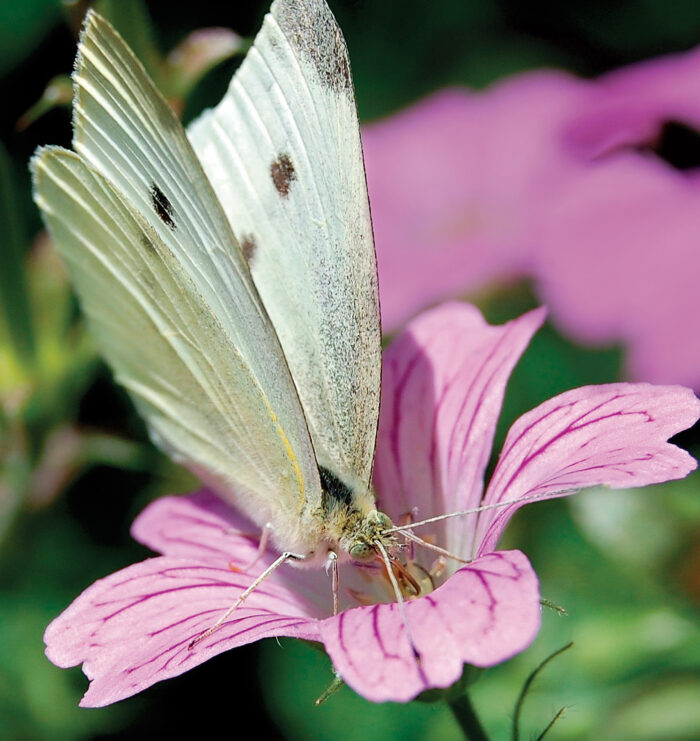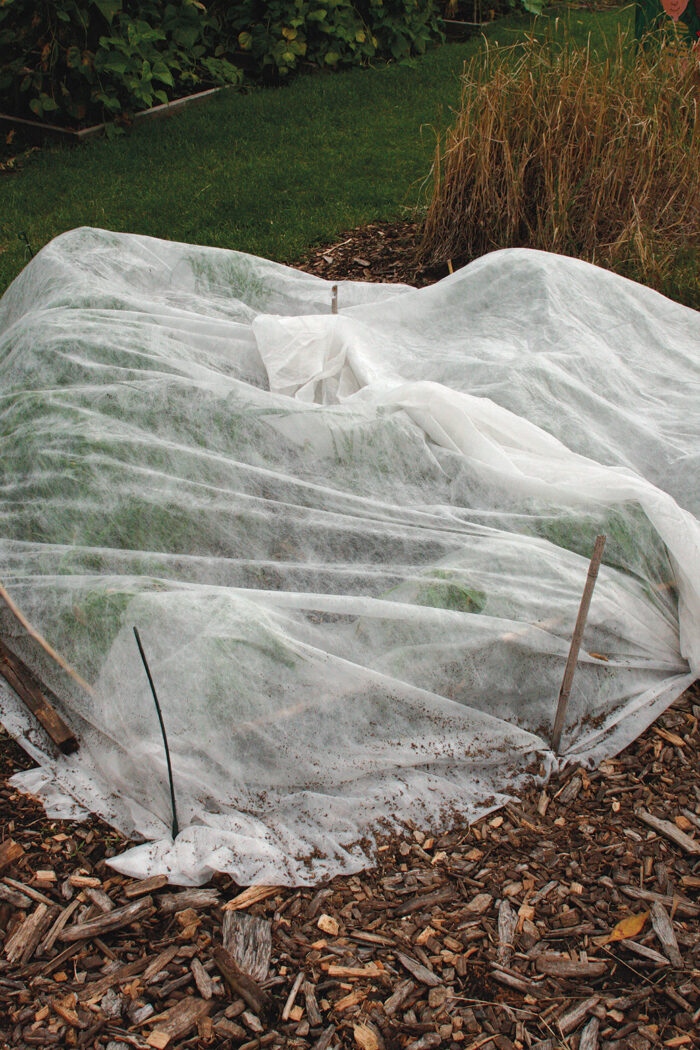Keep Caterpillars in Check in Your Garden
Identification, row covers, natural enemies, and Bt can keep crops from looking like Swiss cheese

Is there a home gardener who hasn’t at least once grown a cabbage that ended up looking like Swiss cheese? Three remarkably cryptic caterpillars are probably the culprits: the cabbage looper, the imported cabbageworm, and the larva of the diamondback moth. Cole crops (members of the crucifer or brassica family) such as broccoli, cabbage, cauliflower, kale, radish, rutabaga, and turnip often suffer leaf damage from these pests.
Identify in winged and worm stages

Imported cabbageworms probably are familiar to you in their adult stage as the lovely white to yellowish butterflies flitting above the garden. The cabbage looper and the diamondback moth are much less conspicuous. The adult moth of the cabbage looper flies at night and has a 1-1/2-inch wingspread. Its coloring is brownish with a silvery spot on each forewing. The looper earns its name from the characteristic way the larva loops along like an inchworm.
The diamondback moth has a distinctive pattern on its wings when they are folded back together against its body. The larvae are very small, approximately 1/3 in. long, and they make smaller holes in the leaves than the other two caterpillars do. These little worms may wriggle frantically or rapidly lower themselves from leaves on a silken thread if disturbed.
If you have keen eyes and lots of time and patience, try hand-picking these green caterpillars. They are not too hard to spot on the undersides of the outer leaves of cabbages. Often the pile of feces and debris they leave behind is a clue to their location. But they become nearly invisible hugging the stalks of broccoli, particularly the velvety green cabbageworm. You may think you have found and removed every one, but the next day twice the number are very likely to show up. What to do?
Row covers keep pests out, and natural enemies keep them at bay

There are a number of approaches you can use to reduce damage from these leaf-eating caterpillars. The first strategy, and a good one to employ in any pest situation, is exclusion. The adult moth form of each caterpillar arrives by air. If you are planting seeds or transplanting seedlings into beds, immediately cover the bed with a row cover to prevent the moths from reaching the leaves to lay their eggs.
However, row covers are not for everyone, so what else can be done? Another strategy to consider is conserving and enhancing the pests’ natural enemies. Cole plants can stand quite a bit of leaf damage between the seedling stage and the time heads start to form. During this “in-between” period, any caterpillars well may be eliminated by some of their many insect and bird predators. Gardens that have not been treated with all-purpose pesticides should abound with many natural enemies of these caterpillars. Plant flowers such as sweet alyssum, yarrow, dill, or daisy-flowered species. You can also let carrot plants reach the flowering stage to create a favorable habitat for beneficial predators like lacewings, spined soldier bugs, and parasitic wasps.
Release mini-wasps during the egg-laying stage
Start monitoring your cruciferous plants in early spring. Look on the upper surface of leaves for tiny, greenish, round eggs. If egg-laying is going on, that is the time to release the parasitoid, Trichogramma. These insects are mini-wasps that lay their eggs inside the caterpillar eggs. When the wasp larvae hatch, they kill and consume the host insects. Trichogramma and other beneficial insects can be purchased by mail from Arbico Organics, 800-827-2847; and Rincon-Vitova Insectaries, 800-248-2847. Explain your situation to get the right Trichogramma species for these pests.
Bt can help your efforts, too
Continue to monitor plants by checking the lower surface of the leaves twice a week for caterpillar damage. If caterpillars are abundant when the heads begin to form, you may want to spray your crop with Bacillus thuringiensis or Bt, a bacterial stomach poison toxic to these caterpillars. After consuming Bt, caterpillars may not die for several days, but they will stop eating and damaging plants immediately. Bt will not harm the many beneficial insects in the garden, and is safe for use on edible plants. If the caterpillar infestation is very heavy, you may have to spray once or twice a week until harvest because Bt breaks down quickly in the garden. Exposure to sunlight hastens breakdown, so try to spray in the late afternoon or on a cloudy day to prolong its effectiveness.
One last word of caution. In all but harsh northern areas, these insects can winter over in garden debris. So rake up and compost in a hot pile all the cabbage family prunings and leftovers. Then, plant next year’s crucifers as far away as possible from the prior year’s location. Rotating crops is a major principle of good pest management. Many insects and disease organisms remain in the soil to plague plants of the same type the following year. Give each spot a rest by switching plant families in each bed from year to year.
This article originally appeared in Kitchen Gardener #6 (December 1996).









Comments
Log in or create an account to post a comment.
Sign up Log in